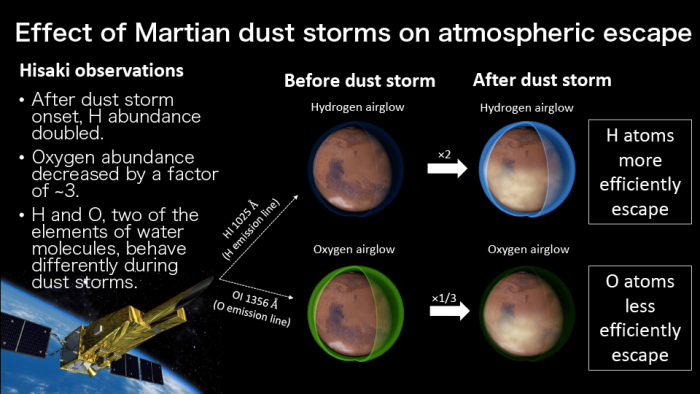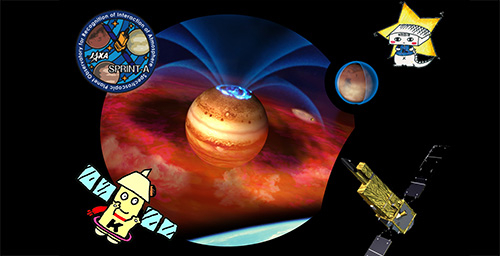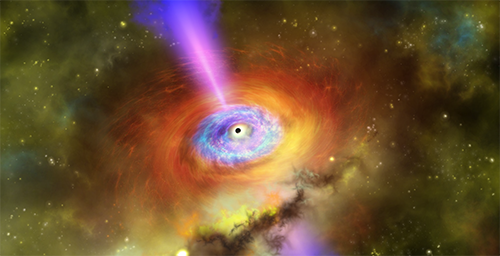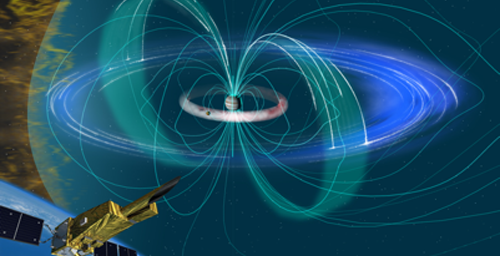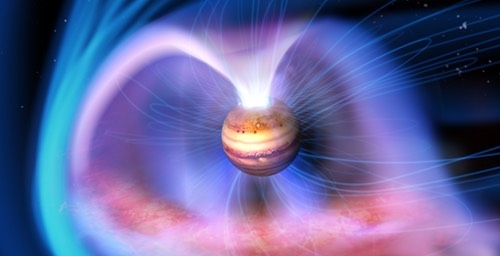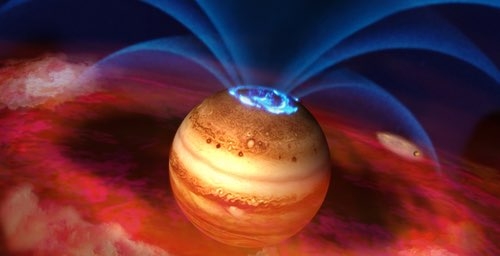(Credit: JAXA)
During a dust storm event on Mars in 2016, the abundance of hydrogen in the upper atmosphere of the planet was observed to gradually grow, accompanied by a temporary decrease in the abundance of oxygen. This inverse relationship suggests that dust storms over Mars's history have increased the oxidation of the atmosphere by increasing escape of hydrogen but reducing escape of oxygen at higher altitudes. Mars may therefore have hosted a more reduced (oxygen-poor) atmosphere in the past compared to today, which might have boosted the planet's habitability.
Overview
Observations of the upper atmosphere of Mars were made using JAXA's Hisaki space telescope and several Martian spacecraft by a team led by MASUNAGA Kei, a researcher at JAXA's Institute of Space and Astronautical Science (ISAS), with members from Tohoku University, Sorbonne University in France, the University of Tokyo, and the Tokyo University of Science. The team found that during a dust storm event in 2016, hydrogen abundance gradually increased in the upper atmosphere of Mars because of water vapor transportation from the lower atmosphere, while oxygen abundance temporarily decreased. This indicates that with increasing escape of hydrogen, oxygen will less efficiently escape from the upper atmosphere during dust storms, leading to a more oxidized atmosphere. Martian dust storms are known to occur seasonally, and if this condition has repeatedly occurred during each dust storm over hundreds of millions of years of Martian history, the Martian atmosphere would have been oxidized by dust storms. This suggests that Mars in the past had a more reduced atmosphere than Mars today. Because the synthesis of organic matter, which constitutes life, is more likely to occur in a reducing atmosphere, the findings of this study may provide insights into the past Martian life environment. The results of this research have been published in Nature Communications.
Background
Mars today has a cold and dry climate, and liquid water does not exist on the planet's surface. However, based on geographical features obtained from recent observations, it is believed that Mars was warmer in the past and once had oceans on the surface. So how did the once-existing oceans disappear? Currently, there are two theories: one is that water was transported underground and remains as ice, and the other is that hydrogen and oxygen, which are components of water, leaked into space in the form of gases. We are conducting observational studies of the Martian atmosphere from the latter perspective of atmospheric outflow in order to understand the whereabouts of water on Mars that existed in the past.
The mechanism of atmospheric outflow from Mars has been understood in detail mainly through the activities of Western Mars robotic explorers. Observations in recent years have shown that when dust storms occur on Mars, water vapor in the lower atmosphere is rapidly transported to the upper atmosphere, and hydrogen gas originating from the water vapor is directly observed leaking from Mars into space. This discovery attracted attention as the study that captured the site of direct outflow of water-based materials from Mars. However, observations of hydrogen gas alone have not allowed us to fully understand the effect of dust storms on the atmospheric outflow from Mars. Therefore, the role of dust storms in atmospheric escape, atmospheric evolution, and climate change on Mars continues to be studied around the world.
In this study, we focused on how Martian dust storms affect the outflow of oxygen, another element in water molecules, as well as hydrogen. Since the oxygen gas expanding in the upper atmosphere of Mars is mainly derived from carbon dioxide, which is the main atmospheric component of Mars, the contribution from water vapor, a trace atmospheric component, is expected to be small, but the details of this contribution have not been clarified. To investigate this, we used data from JAXA's ultraviolet spectroscopy Hisaki space telescope and the European and U.S. Mars spacecraft to analyze variations in various physical parameters across the Martian atmosphere from the lower atmosphere to the upper atmosphere.
Results
We analyzed various types of data on the upper and lower atmosphere of Mars observed simultaneously by JAXA's planetary spectroscopy satellite Hisaki , several Western Mars orbiters (Mars Reconnaissance Orbiter, Mars Express, and Mars Atmosphere and Volatile and Evolution), and a U.S. rover (Curiosity Rover) during the September 2016 dust storms on Mars. First, we analyzed the airglow variations of hydrogen atoms (HI Ly-β) and oxygen atoms (OI 130.4 nm and 135.6 nm) emitted in the Martian upper atmosphere using data from the Mars upper atmosphere spectroscopic observations with Hisaki. These airglow emissions are emitted due to scattering of light from the Sun and collisions with electrons in the ionosphere, and the intensity of the emissions is related to the (column) abundance of the atoms. Using this relationship, we can determine how the total amount of oxygen and hydrogen gases in the Martian upper atmosphere changes during dust storms. In the same time period, we analyzed meteorological data such as the amount of dust in the lower atmosphere, the amount of water vapor and water ice, air temperature, and air pressure observed by Mars Express, Mars Reconnaissance Orbiter, and the Curiosity rover to investigate the relationship between the state of the lower atmosphere and the total amount of hydrogen and oxygen in the upper atmosphere.
The results indicate that the total amount of hydrogen and oxygen gases in the Martian upper atmosphere increases or decreases via dust storms and atmospheric waves generated in the lower atmosphere. In particular, when dust storms occur on Mars, the amount of hydrogen gas in the upper atmosphere temporarily increases by about a factor of two and oxygen gas decreases by about one-third, suggesting that hydrogen gas escapes easily from Mars and oxygen gas escapes less easily from Mars. Dust storms are known to occur seasonally on Mars, developing into major dust storms at least three times a Martian year. If the hydrogen-rich and oxygen-poor conditions we have discovered occur during each dust storm and have been repeated over hundreds of millions of years of Martian history, then the Martian atmosphere has been continuously oxidized by dust storms. This suggests that Mars in the past had a more reductive atmosphere than Mars today. In a reductive atmosphere, it is thought that the synthesis of organic matter is more likely to occur through electrical discharge phenomena such as lightning. Since organic matter is an important component of life, Mars in the past may have had an environment conducive to life, and this study may provide insights into the Martian life environment.
Prospects for future research
Our discovery has implications for JAXA's future Martian Moons eXploration (MMX) mission, the main goal of which is to bring back samples from the Martian moon Phobos to elucidate the origin of the Martian moons. Because Phobos is exposed to the Martian upper atmosphere that has been leaked from Mars, it is believed that the Martian atmospheric components will be transported to Phobos. Therefore, we expect to derive the pollution effects of the Martian atmosphere from the analysis results of the samples we bring back. We hope to understand the mechanisms of atmospheric escape from Mars, which will also lead to a better understanding of the Martian moons' environment for the future MMX mission.
Journal paper information
Paper title: Alternate oscillations of Martian hydrogen and oxygen upper atmospheres during a major dust storm
Journal title: Nature Communications
Date of publication: November 3, 2022
Authors: Kei Masunaga, Naoki Terada, Nao Yoshida, Yuki Nakamura, Takeshi Kuroda, Kazuo Yoshioka, Yudai Suzuki, Hiromu Nakagawa, Tomoki Kimura, Fuminori Tsuchiya, Go Murakami, Atsushi Yamazaki, Tomohiro Usui, and Ichiro Yoshikawa.
DOI: 10.1038/s41467-022-34224-6

